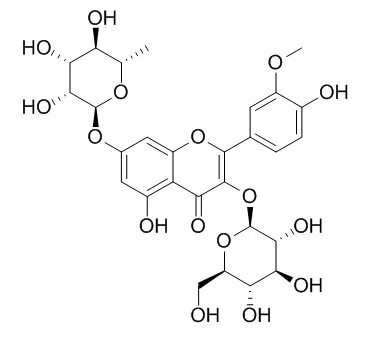| Structure Identification: |
| Journal of Chromatography A, 2007, 1154(1-2):250-259. | | High-performance liquid chromatographic fingerprint analysis for different origins of sea buckthorn berries.[Reference: WebLink] |
METHODS AND RESULTS:
Using high-performance liquid chromatography (HPLC), a chemical fingerprint method was developed for investigating and demonstrating the variance of flavonoids among different origins of sea buckthorn berries. Thirty-four samples were analyzed including 15 RS (Hippophae rhamnoides ssp. sinensis) samples, 7 RY (H. rhamnoindes ssp. yunnanensis) samples, 5 RW (H. rhamnoides ssp. wolongensis) samples, 4 NS (H. neurocarpa ssp. stellatopilosa) samples and 3 TI (H. tibetana) samples. In the HPLC chromatograms, 12 compounds were identified as flavonoids, including quercetin 3-O-sophoroside-7-rhamnoside, kaempferol 3-O-sophoroside-7-O-rhamnoside, isorhamnetin 3-O-sophoroside-7-O-rhamnoside, isorhamnetin 3-O-glucoside-7-O-rhamnoside(Isorhamnetin 3-glucoside-7-rhamnoside), quercetin 3-O-rutinoside, quercetin 3-O-glucoside, isorhamnetin 3-O-rutinoside, isorhamnetin 3-O-glucoside, quercetin, kaempferol 7-O-rhamnoside, kaempferol and isorhamnetin. Both correlation coefficient of similarity in chromatograms and relative peak areas of characteristic compounds were calculated for quantitative expression of the HPLC fingerprints.
CONCLUSIONS:
Our results revealed that the chromatographic fingerprint combining similarity evaluation could efficiently identify and distinguish sea buckthorn berries from different species. However, no obvious difference between RS and RY suggested that the two subspecies might have very close relationship in terms of chemotaxonomy. The established method was considered to be suitable for fingerprint analysis to check the genuine origin and control the quality of sea buckthorn berries and extracts. |
|






 Cell. 2018 Jan 11;172(1-2):249-261.e12. doi: 10.1016/j.cell.2017.12.019.IF=36.216(2019)
Cell. 2018 Jan 11;172(1-2):249-261.e12. doi: 10.1016/j.cell.2017.12.019.IF=36.216(2019) Cell Metab. 2020 Mar 3;31(3):534-548.e5. doi: 10.1016/j.cmet.2020.01.002.IF=22.415(2019)
Cell Metab. 2020 Mar 3;31(3):534-548.e5. doi: 10.1016/j.cmet.2020.01.002.IF=22.415(2019) Mol Cell. 2017 Nov 16;68(4):673-685.e6. doi: 10.1016/j.molcel.2017.10.022.IF=14.548(2019)
Mol Cell. 2017 Nov 16;68(4):673-685.e6. doi: 10.1016/j.molcel.2017.10.022.IF=14.548(2019)